
Johns Hopkins UniversityEst. 1876
America’s First Research University
The Amish: A Concise Introduction

One of the things that continually fascinates me about the Amish is the diversity within this group that can, at first glance, seem entirely uniform. Today there are more than 300,000 Amish living in more than 500 communities across 31 U.S. states and three Canadian provinces. Local contexts and differing Amish traditions mean that each settlement has its own unique character.
This spring I spent time in two Amish settlements, separated by 400 miles – and a number of other factors.
The Nappanee community, in northern Indiana, has the sixth largest Amish population in the country, with some 5,800 Amish adults and children. Amish folks have been living around Nappanee – a small city whose residents are not Amish – since 1842. The Amish around Nappanee drive horse-and-buggy, dress in distinctive garb, and send their children to school only through the eighth grade. (About 80 percent of Nappanee Amish children attend one room Amish schools; the rest attend public schools but only through eighth grade.)
In other ways the Amish in this place are integrated into their local context. Their occupational profile matches that of their non-Amish neighbors and quite unlike that of almost all other Amish in North America. Most Nappanee Amish men punch a timeclock and spend their weekdays on factory jobs producing large motorhomes and other goods for non-Amish customers.
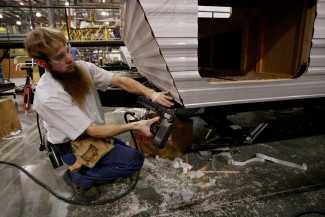
Although visitors to the area around Nappanee would probably consider it a rural locale – the local Chamber of Commerce’s tag line, ‘embrace the pace’ plays on the sense that the pace of life is relaxed – looks can be deceiving. The region is actually highly industrialized, with more than half of all residents, including Amish men, working in factories that churn out recreational vehicles (RVs), campers, modular homes, or components for such vehicles and homes.
Nappanee’s Amish employment profile is unusual by Amish standards. Across the country it’s rare for Amish to work in large scale manufacturing. Households who are not framing generally run small at-home businesses, perhaps building gazebos, offering welding or small-scale metal working, or running greenhouses or retail quilt shops. In Nappanee, however, almost 60 percent of Amish men punch timeclocks for large non-Amish-owned firms, including some owned by distant holding companies, including Berkshire-Hathaway.
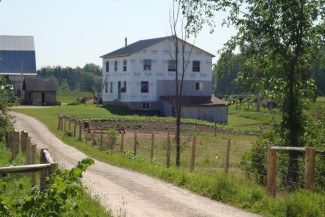
Factory work has contributed to changes in Nappanee Amish life – free weekends and paid vacations give households more discretionary time than farmers ever have, and regular paychecks allow Amish households to eat in restaurants and purchase consumer goods – from prepackaged food to disposable diapers – that would be rare in most Amish settlements. Integration into the wider economy also meant that Nappanee Amish households were hit hard by the 2008-2010 recession when northern Indiana made national headlines and drew a visit from President Obama because it experienced the nation’s sharpest spike in industrial unemployment. The layoffs were a shock to the local Amish community, and some observers speculated that Amish workers would look for other types of employment. But as the economy had rebounded in recent years most Amish here have returned to the local factory floor. Even an interruption as great as the economic downturn of 2008-2010 could not unhook the Amish from their local context.
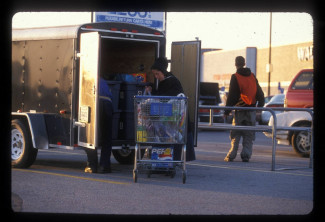
Four hundred miles north, in the Upper Peninsula of Michigan, an Amish community offers a different expression of Amish life. The settlement here is small, new, and much more technologically conservative. Cell phones, for example, which have become more common in some Nappanee Amish quarters, are strictly off limits here.
The first Amish households arrived in Mackinac County, at the northern tip of Lake Michigan, in 2008, moving in from downstate Michigan, and this spring the sixteenth household arrived, from Conneaut, Ohio. Others have come from New York, Pennsylvania, and Wisconsin, looking for a more remote home with fewer “worldly” influence. And the area here is decidedly rural – one of the most sparsely populated counties east of the Mississippi. Gravel backroads are empty and land prices are low – much lower than in a place like suburbanizing Nappanee. “From where we came in Wisconsin, it’s about 20 years behind up here,” one man said.
Yet if rurality is what drew the families who moved here, this new context has also engendered change. Before settling in the Upper Peninsula, most of the community’s families had engaged in dairy farming, milking by hand for a Grade B (cheese) market. However, there is no cheese business in the region and no prospect for one, so families have had to creatively diversify their occupations. Some have signed contracts to raise calves on contract, others have turned to raising sheep. Woodcutting, self-employed carpentry, and a metal roofing business employ others. A few families have opened bake goods stands along a nearby state highway frequented by tourists on their way to summer and winter sports in state parks. One woman has opened a quilt shop.
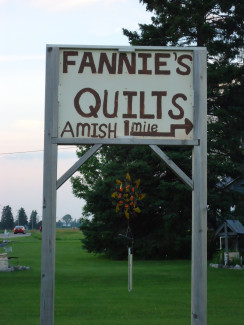
In fact, the closer one looks, the more it seems that the Amish of Engadine, Michigan are connected to their context in ways not so different from those in Nappanee. A couple young Amish men work in a fish packing plant near the village of Naubinway, employed alongside members of the Ojibwa Nation, filleting and packing white fish, shipped to many places but principally New York City. They are well-informed on U.S.-Canada trade policy as it impacts the fishing business and, despite eschewing television and other mass media, still find themselves fielding questions from coworkers about the reality TV show “Amish Mafia.”
As different as these two settlements are – one sizable and historic, in a suburbanizing part of the industrial Midwest, where smart-phone ownership is commonplace, and other small, new, geographically remote, technologically limited – they are both engaged with their neighborhood, their setting, their context.
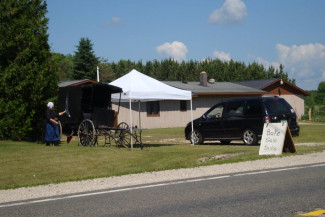
Steven M. Nolt is a professor of history and Senior Scholar at the Young Center for Anabaptist and Pietist Studies at Elizabethtown College. He is the author of A History of the Amish and the coauthor of The Amish. His latest book, The Amish: A Concise Introduction, is available now.


